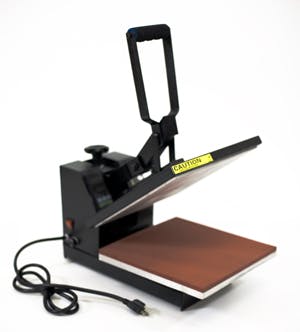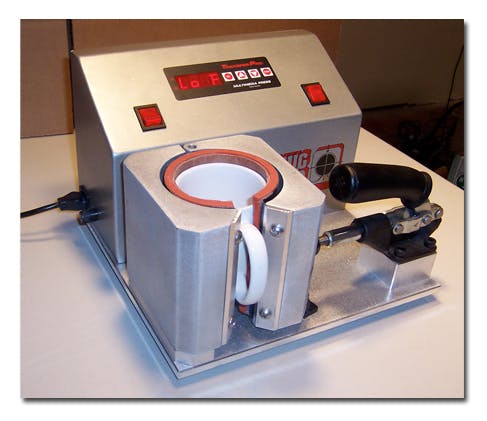In the apparel industry, besides the artwork to be printed, the most important thing is the printing techniques we`re using. There are several printing techniques, and each of them is suitable for a certain business strategy. I hope this will answer many questions concerning the perfect printing technique for your t-shirt business. This is quite simple to see which one fits your needs best, because each printing technique has its pros and cons depending on the number of colors used, on the timing, and not the least, on the costs. I am going to explain each of them and let you decide which method you would prefer.
Apparel printing techniques

SCREEN PRINTING
It’s the most commonly used method for t-shirt printing. It uses screens pressed up against cloth to place paint onto shirts one color per screen. Each press uses a single color, so that means that for a t-shirt design that has 5 colors, you will need 5 separate screens. Screen printing is high quality, professional looking, durable, and can be very price effective on volume orders. Some cons might be the fact that it’s messy to work with many screens. If you want to do one t-shirt or two, that’s definitely not the right choice for printing. Also, screen printing has setup fees, depending on the number of the color screens to be burned. For example, Customink uses this kind of printing when it comes to bulk orders.

DIRECT TO GARMENT PRINTING (DTG)
While screen printing technique is considered to be traditional and known by everybody, direct to garment printing is fairly new. Because it is new, the printer is also very expensive, but the quality of the printed t-shirts is excellent. With the direct to garment printers, the design is printed directly on a t-shirt or on the desired product. The art process allows unlimited colors and shades to be printed, thing that could not be possible with the screen printing. It is the perfect option for photo t-shirts and very detailed images. Direct to garment printing is considered to be the only professional option for low run orders. That means you can print one t-shirt or 100 without problems. The printing process in the case of DTG takes longer than in the case of screen printing and the big disadvantage is that the artwork can’t be printed on dark t-shirts (with few exceptions). Also, that’s the reason why the printer does not print the white color. The result is professional and designs are not felt on the garment.

HEAT PRESS TRANSFER PRINTING
is probably the best choice for a small business, and we are not talking here about starting a clothing line. The heat press transfer technique consists of printing a transparent ink with the use of a computer on a special piece of paper ( Inkjet transfer paper). Full color images and of very high quality can be printed, then applied to the cotton garment and pressed in the heat press. The usual temperature is 180 degrees for 10 – 30 seconds. With the heat transfer, you can print complex designs, with many colors. The advantage is that the colors don’t require to be applied separately. The heat press transfer is ideal for creating fast customized t-shirts. The bad thing is that the colored picture can be applied only on light t-shirts, because the colors in the design might be affected by the t-shirt color. Even that it’s fast and easy to print a t-shirt with the heat press transfer, the feel on transfer is heavy, and it cracks easily.

HEAT TRANSFER VINYL PRINTING
is the perfect option for t-shirt lettering, for small t-shirt orders, for name of bands, clubs, football player and so on. It requires a machine (vinyl cutter) to cut out designs on special color sheets of vinyl. The cut vinyl is applied onto the garment using a heat press.

Heat transfer vinyl is not headed towards mass production, because of the heavy feel of the transfer and also because many colors printing is hard to achieve and need separately heat transfer. There are 50 colors to chose from, including fluorescent colors. This technique is perfect of you want a t-shirt with distinct lettering.

DYE SUBLIMATION PRINTING
is actually the heat transfer onto polyester garments and polyester coated items (such as mugs). Dye subprocess is limited to printing on white or light to medium colored garments that have a 100% polyester surface and allows for full-color printing as well as spot color printing on garments. Sublimation ink is a special ink that turns to gas when the heat is applied. The heat makes polyester pores to open and permanently absorb the sublimation ink. But this is possible with most of the non-textile garments, like mugs, puzzles, key chains, mouse pads etc. This technique can also be applied to polyester t-shirts, but there is a restrained demand in this chapter. Dye sublimation printing also requires a special transfer paper which is cheaper than inkjet transfer paper, but the sublimation ink is very expensive.

Besides these techniques, there are plenty more. Here are some of them, even that they are not used as often as the above ones, they are required in some business areas: plastisol printing, waterbased printing, non-PVC printing, discharge printing, metallic inks, glitter inks, foil, gel, 3d printing, cut and sew, embroidery, thermochromic, photochromic (color changing).

Great site I
Thank you! I would now go on this blog every day!
Dolly
Greatings, ,
Thanks
Nicolas
hey this blog is great. I’m glad I came by this blog. Maybe I can contribute in the near future. PM ME on Yahoo AmandaLovesYou702 Thank you day898
Nice read.
Hi to all,
Anyone Please guide me. I bought a flat heat press machine. But now, I got confused that which method or technique should I use for T-shirt printings. I actually wanted prints like text prints, one color images like clip art, images with transparent in middle and fine, funky images. I actually don’t want to get printed with square look (of paper)after heat press. Please favor me. I want very less expense. Thank a lot.
That screen printing machine is really cool. I took graphics in high school and had to screen print using the traditional box and screen and it is so messy and hard. This would have definitely made the job a lot easier.
This is a wonderful blog site. I’ve been back repeatedly over the past few days and wish to sign up for your rss feed implementing Google but can not understand the right way to do it precisly. Would you know of any sort of tutorials?
How much cheaper would it be if we provide our own shirts?
Wow, I didn’t know there were so many different applications. The DTG process seems the most efficient since you don’t have to switch screens. Do you have to end up with more ink than another like regular printers you would use for documents?
Wow …
Latest technologies and popular designs .
large selling t shirts ..
so here i have also seen a new idea.
their is a website
where you can customized design for your t shirt. Lets create your own designs for your t shirts .
Customised T Shirts printing
Cool website! Thanks for sharing. Apparel printing can be so fun.
You have a helpful list of insights here. Producing promotional apparels is really something businesses should invest in. These items play a vital role in better brand recognition as they reach all kinds of people.
Its really great stuff presented here a it proves useful for all seekers to let understand about the same . Keep it up.
hi…,
This is really blog.
You described all the methods of printing in this very clearly.
i have one more method for printing
I have also one new method to print t-shirts ,shirts etc.
We can use this online and it is called Web to Print design.
I have a buddy at my work who does the t shirt printing in Phoenix and it is fun to see the results. He does comical ones though. Thanks for sharing.
hi Jarries
This is good to see it.
This is also amazing that You can design and print the t-shirt as per your choise.
We have tools for this purpose by which you can do it.
The Regarding article about Apparel printing techniques were such a wonderful.then,so many techniques available in making T-shirts…?wow…
Nice article…
Print Tshirt
I think screen printing is the best and easy method to make whatever design we want in tshirt.because it have a less efficiency for printing designs in more tshirts.
Customized T shirts
Great word press blog here.. It’s hard to find quality writing like yours these days
Amazing job this really awesome so beautiful work. We are providing used Printer’s Parts & Equipment provide high quality Heidelberg printing press, Heidelberg parts, used offset. Thanks for shearing.
wow useful post. this will help us to design a greats t shirts